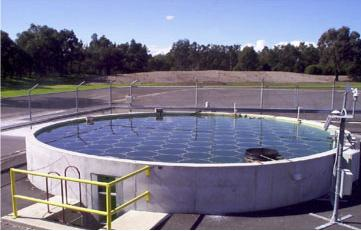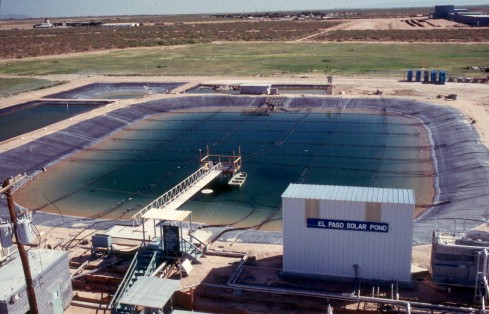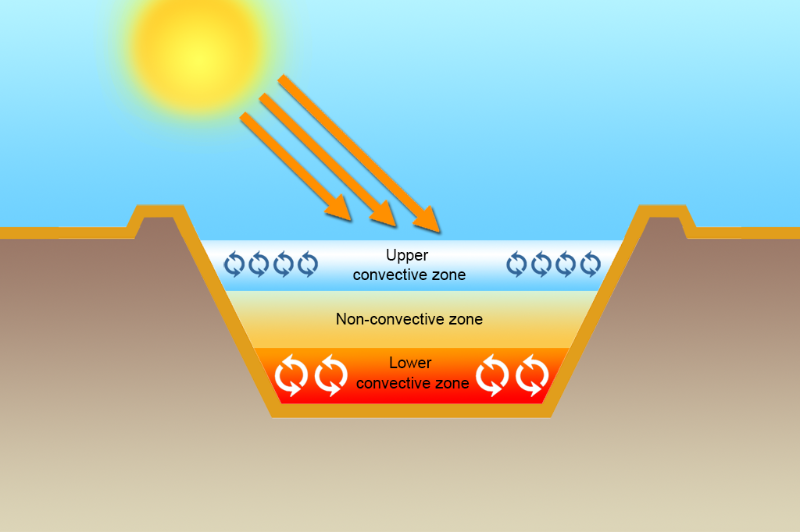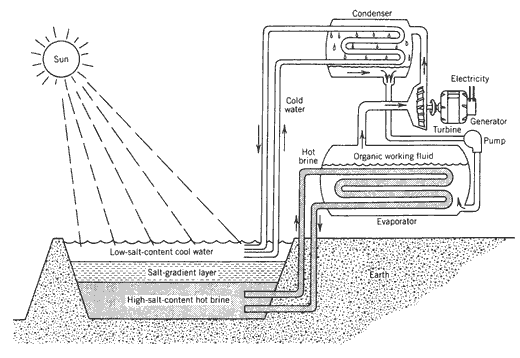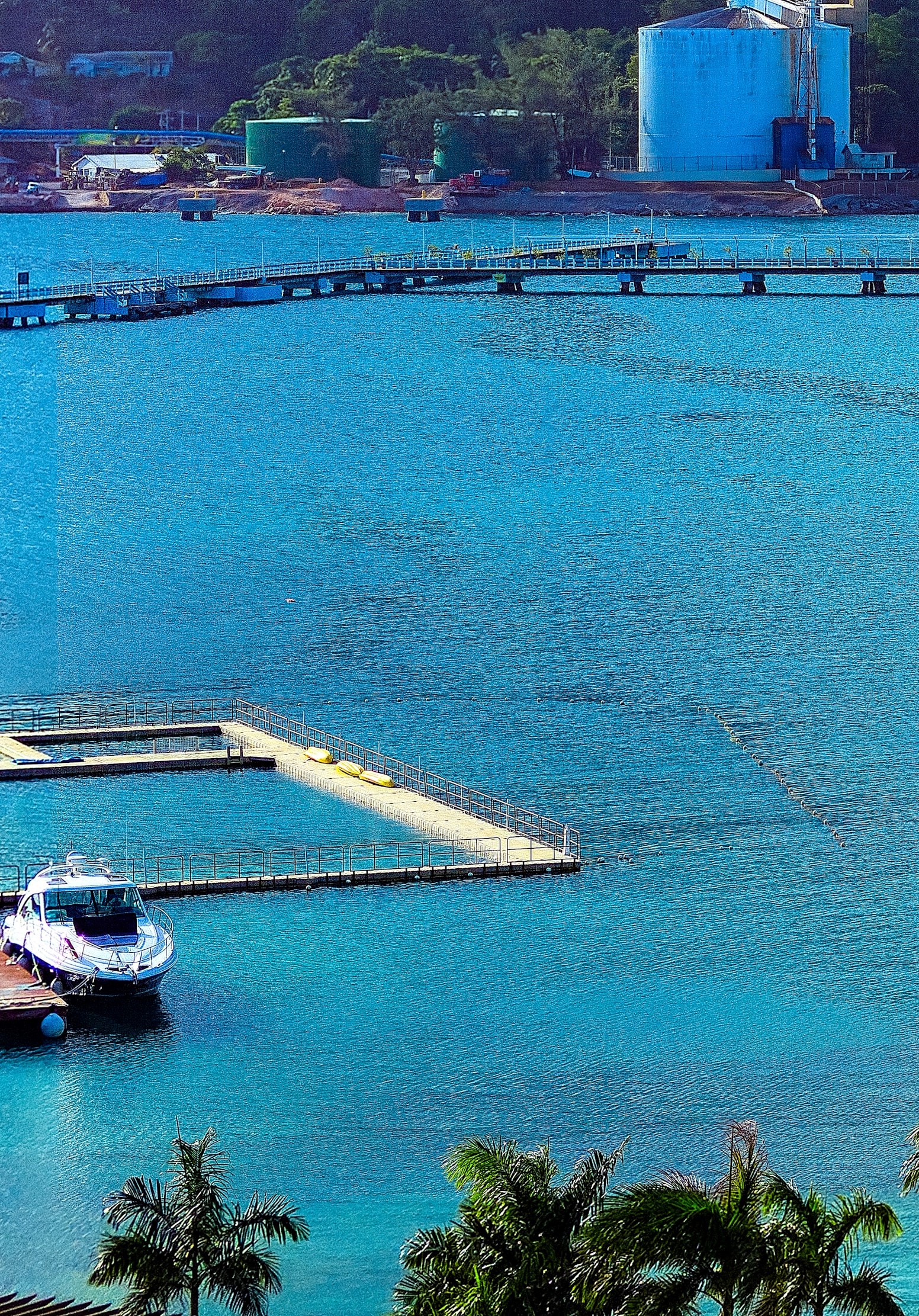
Solar Ponds
What is a solar pond?
A solar pond is one of the simplest and least expensive method to convert solar energy to thermal energy. It looks like normal pond. The solar pond is unique in its ability to act both as collector and as storage. This type of solar energy collectors uses a large salty lake as a kind of flat plate that absorbs and stores energy from Sun in the warm, lower layers of the pond. These ponds can be naturally formed ones or man made. However, most common solar ponds are artificial ones.These kind of energy forms are in the non-conventional energy forms category.
Concentration gradient in a solar pond
As explained earlier, solar pond also looks like a normal pond but the difference is the concentration gradient in the water. In order to maintain this temperature gradient a mechanism is needed to prevent the mixing of the upper and lower water layers of the pond. One method is making the lower layer dense than the upper layer by adding salt. Sodium Chloride and Magnesium Chloride are the salts normally using due to low cost. The ponds using salt to stabilize the lower layers are called “Salinity Gradient” pond.
Another mechanism is “Transparent Honeycomb” structure, which traps the stagnant air and hence provide good transparency for he solar radiation while cutting down the heat loss from the pond. The honeycomb structure is made of transparent plastic material. Instead of the honeycomb, structure transparent polymer gel also can be used because it allows the solar radiation to enter and prevent the radiation from the pond to ambient.
How Solar Pond Works?
The salt concentration gradient of the water allows functioning as a solar energy collector. This concentration gradient results the highly salinized water in to bottom and the concentration decrease toward the surface of the water. The surface water is cool and fresh. The highly salianated water collection at the bottom of the pond is calls as the “storage zone” and the fresh top layer is known as the “surface zone”. The depth of the pond is extend to several meters deep and the “storage zone” is thick to one or two meters.
If the ponds are not properly maintained the sunlight cannot penetrate to the bottom of the pond. So , these pond must properly maintained with the clear water. When the sunlight penetrates, the water and reach the storage zone of at the bottom of the pond it began to heats up. However, this newly heated water cannot rise and thus heat loss upwards is prevented. The salty water cannot rise because it is heavier than the fresh water that is on top of the pond, and thus the upper layer prevents convection currents from forming. Because of these phenomena, the top layer of the pond acts as a type of an insulation blanket.
Therefore, the main heat loss process from the storage unit is stopped. Due preventing the heat loss the bottom of the pond is warmed to extremely high temperatures. Sometimes it can be hats up to 90°C.If the pond is being used to generate electricity this temperature is high enough to initiate and run an engine.
It is a vital necessity that the salt concentrations and cool temperature of the top layer are maintained to proper function of the solar pond. The surface layer is mixed and kept cool by winds and the heat is loses by the evaporation. Continuous flushing of the surface layer with the fresh water ensures there is no accumulation of salt in the top layer, science the salt from the bottom layer diffuse through the saline gradient over time. Additionally, solid salt (Sodium Chloride or Magnesium Chloride) or brine mixture must add to the pond frequently to recover the any upward salt loses.
Applications of the solar ponds energy
The heat energy produced from the solar energy can be used in many different ways. Because of the heat storage ability of the solar pond, it is considering the solar ponds are ideal for heating and cooling the buildings as they can maintain a stable temperature. In combination with the organic Rankine cycle engines simply a turbine-powered by evaporating a fluid (in this case a fluid with a lower boiling point) or thermoelectric devices, solar ponds can be use for electricity generation. Solar ponds can use for desalination purposes as the low cost of this thermal energy can be used to remove the salt from water for drinking or irrigation purposes.
Benefits and drawbacks
One benefit of using these ponds is that they have an extremely large thermal mass. It is measured not in hours or days, but in multiples of week. Since these ponds can store heat energy very well, they can generate electricity during the day when the Sun is shining as well as at night. Solar ponds are simple to build and can easily maintain. So it is a cost effective way to store thermal energy of the sun. Due to the low technological requirements this solar ponds can use in remote areas as an energy source.
Despite being a source of energy, there are numerous thermodynamic limitations because of the relatively low temperatures achieve in these ponds. Because of this, the solar-to-electricity conversion is inefficient – generally less than 2%. As well, large amounts of fresh water are necessary to maintain the right salt concentrations all through the pond. So this solar ponds can’t be built in the places that difficult to find fresh water. These ponds also do not work well at high latitudes as the collection surface is horizontal and cannot be tilted to collect more sunlight.
What is a solar pond? A solar pond is one of the simplest and least expensive method to convert solar energy to thermal energy. It looks like normal pond. The solar pond is unique in its ability to act both as collector and as storage. This type of solar energy collectors uses a large salty…

